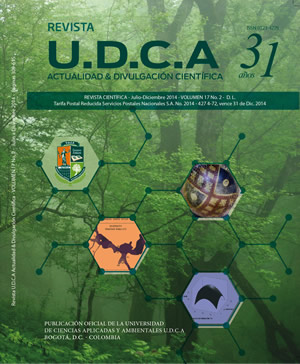Evaluación de la tasa de defecación y del uso de letrinas en la guagua loba (Dinomys branickii Rodentia: Dinomyidae)
Assessment of the defecation rate and the latrine use in the pacarana (Dinomys branickii Rodentia: Dinomyidae)
Contenido principal del artículo
Resumen
El conteo sistemático de grupos de excrementos ha sido utilizado para estimar parámetros poblacionales de diversas especies. La guagua loba (Dinomys branickii), se caracteriza por defecar en letrinas, que son empleadas repetitivamente por un grupo familiar, por lo que el muestreo de la materia fecal constituye una alternativa, más aún, cuando las poblaciones de la especie son pequeñas y con distribución discontinua; sin embargo, la técnica requiere del conocimiento de la tasa de defecación y de la morfología de la materia fecal desconocidas para la especie. El objetivo principal de este trabajo fue el de monitorear las letrinas de tres poblaciones con diferente número de individuos, entre machos y hembras de D. branickii, mantenidas en un ambiente seminatural, con el fin de generar información de la morfología y de la producción diaria de materia fecal. Para cada grupo de animales, se recolectó, se contó y se midió el total de cagarrutas depositadas por letrina. El número total de cagarrutas/animal/día, se obtuvo sirviendose de marcadores fecales. El promedio de las cagarrutas por letrina varían de acuerdo al tamaño del grupo. Las tasas de defecación individual mostraron diferencias estadísticamente significativas entre sexos. La forma cilíndrica de las cagarrutas de D. branickii muestra una clara diferencia entre la longitud y el ancho promedio. Las dimensiones de las cagarrutas variaron con mayor frecuencia en las letrinas que en las muestras individuales. La estimación del tamaño poblacional de D. branickii, a partir del uso de letrinas, es prometedora, pero requiere ser validada en su hábitat natural.
Palabras clave:
Descargas
Datos de publicación
Perfil evaluadores/as N/D
Declaraciones de autoría
- Sociedad académica
- Universidad de Ciencias Aplicadas UDCA
- Editorial
- Universidad de Ciencias Aplicadas y Ambientales U.D.C.A
Detalles del artículo
Referencias (VER)
ALBERICO, M.; OSBAHR, K.; GONZÁLEZ-HERNÁNDEZ, A. 2006. Guagua loba (Dinomys branickii). En: Libro rojo de los mamíferos de Colombia.1 ed. Bogotá, Panamericana Forma e Impresos S.A. p.294-297.
ARAÚJO, A.J.G.; RANGEL, A.; FERREIRA, L.F. 1993. Animal parasitic infection and climate change in Northeastern Brazil. Mem. Inst. Oswaldo Cruz. 88:577-579.
BARNES, R.F.W.; DUNN, A. 2002. Estimating forest elephant density in Sapo National Park (Liberia) with a rainfall model. Afr. J. Ecol. 40:159-163.
BENNET, L.J.; ENGLISH, P.F.; MCCAIN, B. 1940. A study of deer population by use of pellet-group counts. J. Wildlife Managm. 4(4):398-403.
BOHER, S.; MARIN, B. 1988. El pacarana (Dinomys branickii) en Venezuela. Natura. 84:14-18.
CATTADORI, I.M.; HAYDON, D.T.; THIRGOOD, S.J.; HUDSON, P.J. 2003. Are indirect measures of abundance a useful index of population density? The case of red grouse harvesting. Oikos. 100:439-446.
CHAME, M. 2003. Terrestrial mammal feces: A morphometric summary and description. Mem. Inst. Oswaldo Cruz, Rio de Janeiro. 98(Suppl.I):71-94.
CHAPMAN, N. 2004. Faecal pellets of Reeves? muntjac, Muntiacus reevesi: defecation rate, decomposition period, size and weight. Eur. J. Wildl. Res. 50:141-145.
COE, M.J.; CARR, R.D. 1983. The relationship between large ungulate body weight and faecal pellet weight. Afr. J. Ecol. 21(3):165-174.
DE BOER, W.F.; NTUMI, C.P.; CORREIA, A.U.; MAFUCA, J.M. 2000. Diet and distribution of elephant in the Maputo Elephant Reserve, Mozambique. Afr. J. Ecol. 38:188-201.
DELAHAY, R.J.; BROWN, l.A.; MALLINSON, P.J.; SPYVEE, P.D.; HANDOLL, D.; ROGERS, L.M.; CHEESEMAN, C.L. 2000. The use of marked bait in studies of the territorial organization of the European badger (Meles meles). Mammal Review. 30:73-87.
EISENBERG, J.F.; KLEIMAN, D.G. 1972. Olfactory communication in mammals. Ann. Rev. Ecol. and System. 3:1-32.
ESPIRITO-SANTO, C.; ROSALINO, L.M.; SANTOS-REIS, M. 2007. Factors affecting the placement of common genet latrine sites in a Mediterranean landscape in Portugal. J. Mammalogy. 88(1):201-207.
, HOCHACHKA, W.M.; MARTIN, K.; DOYLE, F.; KREBS, C.J. 2000. Monitoring vertebrate population using observation data. Can. J. Zool. 78:527-529.
HOMYACK, J.A.; HARRISON, D.J.; LITVAITIS, J.A.; KROHN, W.B. 2006. Quantifying densities of snowshoe hares in Maine using pellet plots. Wildlife Soc. Bull. 34(1):74-80.
IRWIN, M.T.; SAMONDS, K.E.; RAHARISON, J.L.; WRIGHT, P. 2004. Lemur latrines: Observations of latrine behavior in wild primates and possible ecological significance. J. Mammalogy. 85(3):420-427.
IUCN. 2009. IUCN Red List of Threatened Species. Version 2009.2. Disponible desde Internet en: http://www.iucnredlist.org (con acceso 13/01/10).
JOHNSON, R.P. 1973. Scent marking in mammals. Animal Behaviour. 21:521-535.
KOMERS, P.E.; BROTHERTON, P.N. 1997. Dung pellets used to identify the distribution and density of the dik-dik. Afr. J. Ecol.. 35:124-132.
KREBS, C. 1999. Ecological methodology. Second Edition. University of British Columbia, Addison Wesley Longman Inc., 581p.
KREBS, C.H.J.; BOONSTRA, R.; NAMS, V.; O?DONOGHE, M.; HODGES, K.; BOUTIN, S. 2001. Estimating snowshoe hare population density from pellet plots: a further evaluation. Can. J. Zool. 79:1-4.
LANGBEIN, J.; HUTCHINGS, M.R.; HARRIS, S.; STOATE, C.; TAPPER, S.C.; WRAY, S. 1999. Techniques for assessing the abundance of brown hares Lepus europaeus. Mammal Rev. 29(2):93-116.
LINDENMAYER, D.B.; POSSINGHAM, H.P.; LACY, R.C.; MCCARTHY, M.A.; POPE, M.L. 2003. How accurate are population models? Lessons from landscape tests in a fragmented system. Ecol. Letters. 6:41-47.
LOMBARDI, L.; FERNÁNDEZ, N.; MORENO, S.; VILLAFUERTE, R. 2003. Habitat-related differences in rabbit (Oryctolagus cuniculus) abundance, distribution and activity. J. Mammalogy. 84(1):26-36.
LÓPEZ, L.; LÓPEZ, I.; MORA, J.; OSBAHR, K. 2000. Estudio preliminar del comportamiento de Dinomys branickii (Peters, 1873) en cautiverio. Rev. U.D.C.A Act. & Div. Cient. 3(1):28-35.
McCARTHY, M.A.; ANDELMAN, S.; POSSINGHAM, H.P. 2003. Reliability of relative predictions in population viability analysis. Conserv. Biol. 17(4):982-989.
MURRAY, D.L.; ROTH, J.D.; ELLSWORTH, E.; WIRSING, A.J.; STEURY, T.D. 2002. Estimating low-density snowshoe hare populations using fecal pellet counts. Can. J. Zool. 80(4):771-781.
MURRAY, D.L.; ELLSWORTH, E.; ZACK, A. 2005. Assessment of potential bias with snowshoe hare fecal pellet-plot. J. Wildlife Managem. 69(1):385-395.
MYKYTOWYCZ, R.; GAMBALE, S. 1969. The distribution of dunghills and the behaviour of free living rabbits, Orytolagus cuniculus (L.), on them. Form and Function. 1:333-349.
NEFF, D.J. 1968. The pellet-group counting technique for big game trend, census and distribution: A review. J. Wildlife Managem. 32(3):597-614.
OSBAHR, K.; BAUTISTA, J.L. 1998. Contribución al conocimiento de un parásito nemátodo (Oxiuridae) de la guagua loba (Dinomys branickii). Rev. U.D.C.A Act. & Div. Cient. 1(1):34-42.
OSBAHR, K. 1999. Identificación de plantas consumidas por Agouti taczanowskii y Dinomys branickii a partir de fragmentos vegetales recuperados en heces. Rev. U.D.C.A Act. & Div. Cient. 2:42-49.
OSBAHR, K.; RESTREPO, D. 2002. Determinación de calcio, hierro, proteína y otros requerimientos de nutrientes de Dinomys branickii (Peters 1873). Rev. U.D.C.A Act. & Div. Cient. 4 (1):44-55.
OSBAHR, K.; ORTÍZ, D.; PÉREZ-TORRES, J. 2007. Amplitud de nicho y selectividad alimentaria del borugo de páramo (Cuniculus taczanowskii) (Stolzmann 1885) en un bosque andino nublado (Zipacón ? Cundinamarca). Rev. U.D.C.A Act. & Div. Cient. 10(2):105-114.
OSBAHR, K.; ACEVEDO, P.; VILLAMIZAR, A.; ESPINOSA, D. 2009. Comparación de la estructura y de la función de los miembros anterior y posterior de Cuniculus taczanowskii y Dinomys branickii. Rev. U.D.C.A Act. & Div. Cient. 12(1):37-51.
PALOMARES, F. 1993. Faecal marking behaviour by free-ranging common genets Genetta genetta and Egyptian mongooses Herpestes ichneumon in southwestern Spain. Zeitschrift f?r S?ugetierkunde. 58:225-231.
PÉREZ-MEJÍA, S.; MANDUJANO, S.; MARTÍNEZ-ROMERO, L.E. 2004. Tasa de defecación del venado cola blanca, Odocoileus virginianus mexicanus, en cautividad en Puebla, México. Acta Zool. Mex. (n.s.). 20(3):167-170.
PUTMAN, R. J. 1984. Facts from feces. Mammal Rev. 14:79-97.
RINEY, T. 1957. The use of faeces counts in studies of several free-ranging mammals in New Zealand. New Zealand J. Sci. Techn. B. 38(6):507-532.
ROPER, T.J.; CONRADO, L.; BUTLER, J.; CHRISTIAN, S.E.; OSTLER, J.; SCHMID, T.K. 1993. Territorial marking with faeces in badgers Meles meles a comparison of boundary and hinterland latrine use. Behaviour. 127:289-307.
SCOTT MILLS, L.; GRIFFIN, P.C.; HODGES, K.E.; MCKELVEY, K.; RUGGIERO, L.; ULIZIO, T. 2005. Pellet count indices compared to mark-recapture estimates for evaluating snowshoe hare density. J. Wildlife Managem. 69(3):1053-1062.
SIMONETTI, J. 1989. Tasas de defecación y descomposición de fecas de Oryctolagus cuniculus en Chile Central. Medio ambiente 10(1):92-95.
SNEDDON, I.A. 1991. Latrine use in the European rabbit (Oryctolagus cuniculus). J. Mammalogy. 72:769-745.
SOKAL, R.R.; ROHLF, F.J. 2000. Biometry. Principles and Practices of Statistics in Biological Research. Tercera Edición. Freeman and Company. New York (USA). 887p.
SPRENT, J.A.; ANDERSEN, N.A.; NICOL, S.C. 2006. Latrine use by the short-beaked echidna (Tachyglossus aculeatus). Australian Mammalogy. 28:131-133.
STILLMAN, R.A.; CALDOW, R.W.G.; GOSS-CUSTARD, J.D.; ALEXANDER, M.J. 2000. Individual variation in intake rate: the relative importance of foraging efficiency and dominance. J. Anim. Ecol. 69:484-493.
SULKAVA, R.; M?KEL?, A.; KOTIAHO, J.S.; M?NKK?NEN, M. 2008. Difficulty of getting accurate and precise estimates of population size: the case of the Siberian flying squirrel in Finland. Ann. Zool. Fennici. 45:521-526.
THEUERKAUF, J.; ELLENBERG, H. 2000. Movements and defaecation of forest elephants in the moist semi-deciduous Bossematié Forest Reserve, Ivory Coast. Afr. J. Ecol. 38:258-261.
TUYTTENS, F.A.M.; LONG, B.; FAWCETT, T.; SKINNER, A.; BROWN, J.A.; CHEESEMAN, C.L.; RODDAM, A.W.; MACDONALD, D.W. 2001. Estimating group size and population density of Eurasian badgers Meles meles by quantifying latrine use. J. Appl.Ecol. 38:1114-1121.
URY, H.K. 1976. A comparison of four procedures for multiple comparisons among means (pairwise contrasts) for arbitrary sample sizes. Technometrics. 18:89-97.
VERNES, K. 1999. Pellet counts to estimate density of a rainforest kangaroo. Wildlife Soc. Bull. 27(4):991-996.
VUCETICH, J.A.; WAITE, T.A.; QVARNEMARK, L.; IBARG?EN, S. 2000. Population variability and extinction risk. Conserv. Biol. 14:1704-1714.
WHITE, T.G.; ALBERICO, M.S. 1992. Dinomys branickii. Mammalian Species No. 410. The American Society of Mammalogists. p.1-5.
WOODS, C.A. 1984. Hystricognath rodents. En: Anderson, S.; Jones, K. Orders and families of recent mammals of the world. John Wiley and Sons, New York.,U.S.A. p.389-446.
ZAHRATKA, J.L.; BUSKIRK, S.W. 2007. Is size of fecal pellets a reliable indicator of species of leporids in the southern rocky mountains? J. Wildlife Managem. 71(6):2081-2083.
ZOLLNER, P.A.; SMITH, W.P.; BRENNAN, L.A. 1996. Characteristics and adaptive significance of latrines of swamp rabbits (Sylvilagus aquaticus). J. Mammalogy. 77(4):1049-1058







